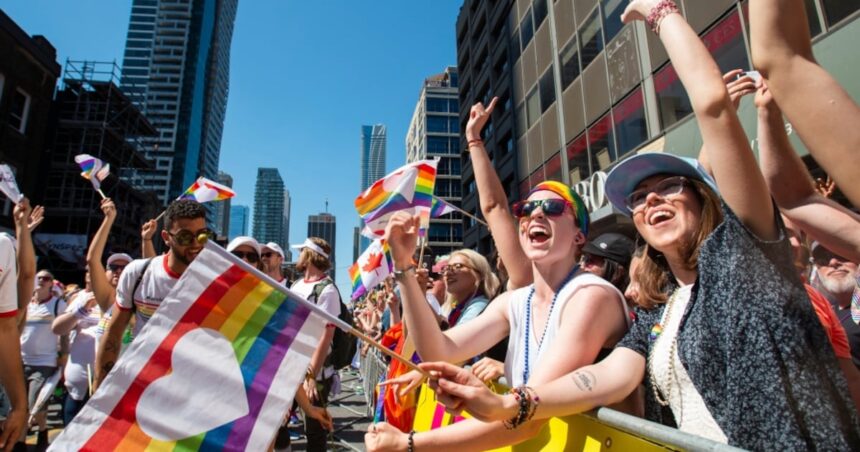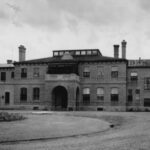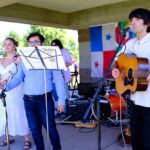The heart of Toronto was awash in rainbow colours today as thousands gathered for the city’s 44th annual Pride Parade, marking what many participants called a crucial moment for 2SLGBTQ+ rights in an increasingly divided political landscape.
Downtown streets pulsed with music and cheers as the parade wound its way from the corner of Church and Bloor streets down to Yonge-Dundas Square. The celebration follows a month of Pride events that have brought both joy and reflection to Canada’s largest city.
“This isn’t just a party—it’s a statement,” said Michelle Rowan, a 34-year-old parade attendee who traveled from Oshawa with her partner. “With everything happening politically, showing up feels more important than ever.”
The parade featured over 200 community groups, businesses, and political contingents. Prime Minister Justin Trudeau made his customary appearance, walking alongside Toronto Mayor Olivia Chow and Ontario Premier Doug Ford, who joined the celebration for the first time since taking office—a move some activists viewed with skepticism given his government’s policies affecting gender education.
Pride Toronto Executive Director Sherwin Modeste emphasized how the event balances celebration with advocacy. “We’ve created a safe space for expression, but we’re also highlighting the challenges our communities still face,” Modeste told me during a brief interview at the parade’s assembly point.
The massive turnout contrasts with challenges facing similar events across North America. Recent pride celebrations in smaller Canadian municipalities have faced increasing pushback, with Hamilton’s Pride event experiencing protests that required police intervention last month.
Local business owner Jasmine Singh, whose Queen Street shop was decorated with pride flags, noted the economic impact. “This weekend brings in probably twenty percent of our summer revenue,” she explained. “But it’s also about showing support—most of my staff are queer, and this matters to them.”
Weather cooperated for most of the day, with temperatures hovering around 26°C under partly cloudy skies—a welcome relief for marchers wearing elaborate costumes and carrying banners along the 4-kilometre route.
The parade’s theme, “United for Love,” resonated with many participants. “It feels like we’re pushing back against a wave of hate,” said Carlos Mendez, a parade marshal and long-time community organizer. “I’ve been doing this for fifteen years, and the energy today reminds me why we can’t take progress for granted.”
According to Toronto Police, approximately 1.8 million people lined the parade route—numbers that nearly match pre-pandemic attendance records. The economic impact of Pride Month events is estimated at over $250 million for the city’s tourism and hospitality sectors, based on data from Tourism Toronto.
Several attendees mentioned the political dimension of this year’s celebration. “There’s an election coming in Ontario, and we’re paying attention to which politicians show up—and which ones don’t,” said Divya Sharma, a university student volunteering with a community organization. “These aren’t just photo ops for us.”
The parade featured notable performances from drag artists, cultural groups, and the Toronto Gay Men’s Chorus, whose rendition of “True Colors” brought the crowd near Church and Wellesley to a momentary, emotional standstill.
Health organizations also maintained a significant presence, with booths offering information about HIV prevention, mental health resources, and gender-affirming care. Toronto Public Health reported distributing over 50,000 condoms and testing kits throughout the weekend’s events.
Behind the scenes, hundreds of volunteers managed logistics, with many having started their day before sunrise. “I’ve been up since four this morning,” said volunteer coordinator Jamal Williams. “But seeing people’s faces when they spot their community marching—that makes it all worthwhile.”
For some long-time activists, the parade represents both progress and unfinished business. “I marched in the first one in 1981, when we were protesting police raids,” said Eleanor Fitzpatrick, 73, watching from a wheelchair along Yonge Street. “We’ve come so far, but lately it feels like we’re fighting some of the same battles again.”
The celebrations continue into the evening with concerts at several venues, including a headline performance at Yonge-Dundas Square featuring several Canadian artists.
Pride Toronto organizers have already announced plans for an expanded festival next year, with hopes to make the event more accessible for families and seniors. “We’re listening to feedback,” said Modeste. “This is about creating community for everyone under our rainbow.”
As the parade finished its route in the late afternoon, the clean-up crews moved in while festivities continued at local establishments. For many participants, the day represented more than just a celebration—it was a reminder of community resilience.
“I brought my teenage son today for his first Pride,” said Michael Chen, standing near the parade’s end point. “I want him to see that no matter who you are or who you love, there are people who will stand with you. That’s what today means to me.”






